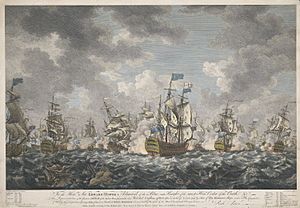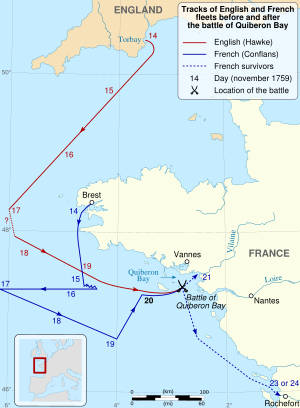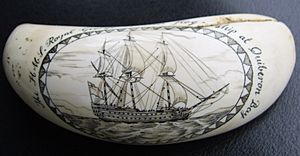Battle of Quiberon Bay facts for kids
Quick facts for kids Battle of Quiberon Bay |
|||||||
|---|---|---|---|---|---|---|---|
| Part of the Seven Years' War | |||||||
 The Battle of Quiberon Bay, Richard Paton |
|||||||
|
|||||||
| Belligerents | |||||||
| Commanders and leaders | |||||||
| Strength | |||||||
| 24 ships of the line 5 frigates 14,000 crewmen |
21 ships of the line 6 frigates 10,000 crewmen |
||||||
| Casualties and losses | |||||||
| 2 ships of the line wrecked, 300 killed or wounded |
3 ships of the line destroyed 3 ships of the line captured 1,700 killed or wounded 1,300 captured |
||||||
The Battle of Quiberon Bay was a very important naval battle during the Seven Years' War. It happened on November 20, 1759. The battle was fought between the Royal Navy of Great Britain and the French Navy. It took place in Quiberon Bay, off the coast of France.
This battle was the final step in Britain's plan to stop France's strong navy. France had been planning to invade Great Britain. A British fleet of 24 large warships, called ships of the line, was led by Sir Edward Hawke. They found and fought a French fleet of 21 ships of the line, led by Marshal de Conflans.
After a tough fight, the British fleet won a huge victory. They sank or ran aground six French ships and captured one. The rest of the French ships scattered. This battle ended the threat of a French invasion for good. It also showed that the Royal Navy was becoming the strongest navy in the world. For the British, this win was part of their "Year of Wonders" in 1759.
Contents
Why the Battle Happened
The Seven Years' War Begins
The Seven Years' War was a big conflict that started in 1756. It involved many countries across Europe. France, Austria, and Russia fought against Britain and Prussia. France wanted to fight Britain for control of colonies and trade routes.
By 1759, neither side was winning clearly. Both countries were also running out of money to pay for the war. France, in particular, had money problems. Their navy was struggling with a lack of experienced sailors.
France Plans an Invasion
To try and win the war, the French king, Louis XV, planned to invade Britain. They gathered an army of 17,000 soldiers in Brittany, France. Nearly 100 transport ships were ready near Quiberon Bay. These ships needed warships to protect them during the invasion.
However, France had trouble finding enough skilled sailors. Many French sailors were prisoners of the British. Others preferred to work as privateers, which could be more profitable. Life on navy ships was also hard, with low pay. This made it difficult to find enough men for their large fleet.
British Blockade and French Challenges
The French navy had 43 ships in home waters. But they were short of over 9,000 sailors. Their main port was Brest, but it was hard to supply. A sickness in Brest had also killed many sailors.
In August, the French fleet from the Mediterranean tried to sail into the Atlantic. But the British fleet, led by Edward Boscawen, stopped them. This was called the Battle of Lagos. Three French ships were captured, two were destroyed, and five were trapped. This made the French invasion plans even harder.
Leading Up to the Battle
Throughout 1759, the British fleet, led by Admiral Hawke, kept a close watch on the French coast near Brest. This was a blockade. The French still hoped to invade Britain, perhaps Scotland. So, their fleet was ordered to escape the blockade. They needed to pick up the transport ships waiting in the Gulf of Morbihan.
In early November, a strong storm hit. Hawke's ships were forced to leave their blockade and sail to Torbay, England. A smaller British squadron, led by Robert Duff, stayed behind in Quiberon Bay. They watched the French transport ships.
Meanwhile, a small French squadron joined Conflans in Brest. When the wind changed on November 14, Conflans' fleet secretly sailed out. British ships spotted them and tried to warn Hawke and Duff. Hawke quickly sailed his fleet towards Quiberon Bay, even in bad weather. Duff also bravely sailed his squadron out to sea.
The Battle Begins
Conflans had slowed down his fleet to arrive at Quiberon Bay at dawn on November 20. He spotted Duff's small squadron and chased them. But then, Hawke's main British fleet appeared.
Hawke ordered his ships to form a line. Conflans had to choose: fight in the rough seas or try to hide in the dangerous Quiberon Bay. He chose to enter the bay, which was full of hidden rocks and reefs. Hawke, despite the danger, ordered his ships to chase the French at full speed.
Around 2:30 PM, Conflans' ships reached Les Cardinaux (The Cardinals). These are rocks at the end of the Quiberon peninsula. The battle gets its French name, Bataille des Cardinaux, from these rocks. The first shots were fired as the French entered the bay. The British ships were catching up to the rear of the French fleet.
Fierce Fighting and Losses
Just before 4 PM, the French ship Formidable surrendered to the British ship Resolution. At the same time, Hawke's own ship, Royal George, entered the bay.
The French ship Thésée tried to help Conflans. But it turned too sharply without closing its lower gunports. Water rushed in, and the ship sank quickly. Only 22 sailors survived. Another French ship, Superbe, also sank. The badly damaged French ship Héros surrendered. It then ran aground on a sandbank during the night.
The wind changed, making things even more confusing for the French fleet. Conflans tried to escape back to the open sea. His flagship, Soleil Royal, headed for the bay entrance. Hawke saw a chance to attack Soleil Royal. Another French ship, Intrépide, bravely moved in the way to take the fire.
Soleil Royal was forced to anchor away from the rest of the French fleet. By 5 PM, it was dark, and Hawke ordered his ships to anchor.
After the Darkness
During the night, eight French ships managed to escape through the dangerous shoals. They reached the port of Rochefort. Seven other French ships and some frigates were trapped in the Vilaine estuary. Hawke could not attack them in the stormy weather. These ships threw their guns overboard to become lighter. They used the rising tide to escape over a sandbar. One of these ships was wrecked. The remaining six were trapped by a British blockade for a long time.
The damaged French ship Juste was lost as it tried to reach the Loire River. The British ship Resolution also ran aground during the night.
Soleil Royal tried to escape to safety near the shore. But the British ship Essex chased it. Both ships ended up wrecked on the same sandbank as Héros. The next day, the storm calmed down. The French set fire to Soleil Royal, and the British burned Héros.
What Happened Next
The British continued to keep a strong blockade on the French coast. This stopped French trade and further hurt France's economy. Hawke tried to destroy the French warships trapped in the Vilaine Estuary, but he was not successful.
The French navy's power was broken. They could not recover before the war ended. This victory, along with Admiral Edward Boscawen's win at the Battle of Lagos earlier, removed the threat of a French invasion of Britain.
Hawke was a bit disappointed he hadn't captured more ships. He felt that with two more hours of daylight, he could have taken the entire French fleet. However, his victory was still huge. He was later made a lord in 1776.
Historians say this battle was one of the most exciting sea battles of its time. It showed that the British navy was now the strongest in the world. Because of this battle, France could not send help to their forces in Canada. This meant the Battle of Quiberon Bay helped decide the fate of New France and Canada.
The battle was one of many British victories in 1759. This year became known as an annus mirabilis, which means "year of wonders" in Latin. From this battle, and the capture of Quebec by General James Wolfe, comes a famous Royal Navy toast: "May our officers have the eye of a Hawke and the heart of a Wolfe."
Ships in the Battle
French Ships

| Name | Guns | Commander | Notes |
| First Division | |||
| Soleil Royal | 80 | Paul Osée Bidé de Chézac | Flagship of Marquis de Conflans – Ran aground and burnt |
| Orient | 80 | Alain Nogérée de la Filière | Escaped to Rochefort |
| Glorieux | 74 | René Villars de la Brosse-Raquin | Escaped to the Vilaine, later returned to Brest |
| Robuste | 74 | Fragnier de Vienne | Escaped to the Vilaine, later returned to Brest |
| Dauphin Royal | 70 | André d'Urtubie | Escaped to Rochefort |
| Dragon | 64 | Louis-Charles Le Vassor de La Touche | Escaped to the Vilaine |
| Solitaire | 64 | Louis-Vincent de Langle | Escaped to Rochefort |
| Second Division | |||
| Tonnant | 80 | Antoine de Marges de Saint-Victoret | Flagship of Chevalier de Beauffremont – Escaped to Rochefort |
| Intrépide | 74 | Charles Le Mercerel de Chasteloger | Escaped to Rochefort |
| Thésée | 74 | Guy François de Kersaint | Sank during the battle |
| Superbe | 70 | Jean-Pierre-René-Séraphin du Tertre de Montalais | Sunk by Royal George |
| Northumberland | 64 | Belingant de Kerbabut | Escaped to Rochefort |
| Éveillé | 64 | Pierre-Bernardin Thierry de La Prévalaye | Escaped to the Vilaine, later returned to Brest |
| Brillant | 64 | Louis-Jean de Kerémar | Escaped to the Vilaine |
| Third Division | |||
| Formidable | 80 | Louis de Saint-André du Verger | Flagship of De Saint André du Vergé – Captured by Resolution |
| Magnifique | 74 | Bigot de Morogues | Escaped to Rochefort |
| Héros | 74 | Vicomte de Sanzay | Surrendered, ran aground, and burnt |
| Juste | 70 | François de Saint-Allouarn | Wrecked in the Loire |
| Inflexible | 64 | Tancrede | Lost at the entrance to the Vilaine |
| Sphinx | 64 | Goyon | Escaped to the Vilaine, later returned to Brest |
| Bizarre | 64 | Prince de Montbazon | Escaped to Rochefort |
| Frigates and corvettes | |||
| Hébé | 40 | Returned to Brest | |
| Aigrette | 36 | Escaped to the Vilaine | |
| Vestale | 34 | Escaped to the Vilaine | |
| Calypso | 16 | Paul Alexandre du Bois-Berthelot | Escaped to the Vilaine |
| Prince Noir | 6 | Pierre-Joseph Kergariou de Roscouet | Escaped to the Vilaine |
| Other | |||
| Vengeance | ? |
British Ships
| Name | Guns | Commander | Notes |
| Royal George | 100 | John Campbell | Flagship of Sir Edward Hawke |
| Union | 90 | Thomas Evans | Flagship of Sir Charles Hardy |
| Duke | 80 | Samuel Graves | |
| Namur | 90 | Matthew Buckle | |
| Mars | 74 | James Young | |
| Warspite | 74 | Sir John Bentley | |
| Hercules | 74 | William Fortescue | |
| Torbay | 74 | Augustus Keppel | |
| Magnanime | 74 | Viscount Howe | |
| Resolution | 74 | Henry Speke | Wrecked on Le Four shoal |
| Hero | 74 | George Edgcumbe | |
| Swiftsure | 70 | Sir Thomas Stanhope | |
| Dorsetshire | 70 | Peter Denis | |
| Burford | 70 | James Gambier | |
| Chichester | 70 | William Saltren Willet | |
| Temple | 70 | Washington Shirley | |
| Essex | 64 | Lucius O'Brien | Wrecked on Le Four shoal |
| Revenge | 64 | John Storr | |
| Montague | 60 | Joshua Rowley | |
| Kingston | 60 | Thomas Shirley | |
| Intrepid | 60 | Jervis Maplesden | |
| Dunkirk | 60 | Robert Digby | |
| Defiance | 60 | Patrick Baird | |
| Rochester | 50 | Robert Duff | |
| Portland | 50 | Mariot Arbuthnot | |
| Falkland | 50 | Francis Samuel Drake | |
| Chatham | 50 | John Lockhart | |
| Venus | 36 | Thomas Harrison | |
| Minerva | 32 | Alexander Hood | |
| Sapphire | 32 | John Strachan | |
| Vengeance | 28 | Gamaliel Nightingale | |
| Coventry | 28 | Francis Burslem | |
| Maidstone | 28 | Dudley Digges |
Named After the Battle
HMAS Quiberon was a destroyer warship. It was named in memory of the Battle of Quiberon Bay. This ship served in the Royal Navy and then the Royal Australian Navy. Quiberon was launched in 1942 and fought in World War II. It was taken out of service in 1964.





